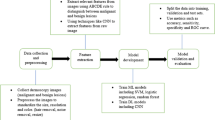Abstract
The survival of melanoma patients greatly depends on a timely diagnosis followed by the definition of the most suitable treatment. In the last decade, the number of available therapies for melanoma has increased. However, most patients still respond differently to each of them, resulting in an increased health and financial burden. Therefore, it is critical to identify new mechanisms that allow the design of more personalized treatment protocols. Nowadays, it is a standard procedure to screen melanoma patients for BRAF mutations, through a biopsy followed by a PCR analysis. This process takes a considerable amount of time and exhibits different levels of sensitivity. Thus, there is a need to not only accelerate this process, but also automatize it. In this work we propose a new mechanism based on Deep Learning (DL) to predict the BRAF status from dermoscopy image biomarkers. Our preliminary results show that this is a promising venue of research, outperforming previous medical studies.
M. R. Verdelho and S. Gonçalves—Equal contribution.
Access this chapter
Tax calculation will be finalised at checkout
Purchases are for personal use only
Similar content being viewed by others
Change history
17 April 2023
A correction has been published.
Notes
- 1.
- 2.
The complete results are presented in the Support Material document.
References
Alom, M.: Adam optimization algorithm (2021)
Armengot-Carbó, M., Nagore, E., García-Casado, Z., Botella-Estrada, R.: The association between dermoscopic features and BRAF mutational status in cutaneous melanoma: significance of the blue-white veil. J. Am. Acad. Dermatol. 78, 920–926.e4 (2018)
Brinker, T.J., et al.: Deep learning approach to predict sentinel lymph node status directly from routine histology of primary melanoma tumours. Eur. J. Cancer 154, 227–234 (2021)
Chen, T., Kornblith, S., Norouzi, M., Hinton, G.: A simple framework for contrastive learning of visual representations. In: International Conference on Machine Learning, pp. 1597–1607. PMLR (2020)
Codella, N.C.F., et al.: Skin lesion analysis toward melanoma detection: a challenge at the 2017 international symposium on biomedical imaging (ISBI), hosted by the international skin imaging collaboration (ISIC). In: 2018 IEEE 15th International Symposium on Biomedical Imaging (ISBI 2018), pp. 168–172 (2018). https://doi.org/10.1109/ISBI.2018.8363547
Combalia, M., et al.: BCN20000: dermoscopic lesions in the wild. arXiv abs/1908.02288 (2019)
Davis, L.E., Shalin, S.C., Tackett, A.J.: Current state of melanoma diagnosis and treatment. Cancer Biol. Ther. 20(11), 1366–1379 (2019)
Finlayson, G.D., Trezzi, E.: Shades of gray and colour constancy. In: Color and Imaging Conference, vol. 2004, pp. 37–41. Society for Imaging Science and Technology (2004)
Gidaris, S., Singh, P., Komodakis, N.: Unsupervised representation learning by predicting image rotations. In: International Conference on Learning Representations (ICLR), Vancouver, Canada (2018). http://hal-enpc.archives-ouvertes.fr/hal-01864755
He, K., Zhang, X., Ren, S., Sun, J.: Deep residual learning for image recognition. In: 2016 IEEE Conference on Computer Vision and Pattern Recognition (CVPR), pp. 770–778 (2016). https://doi.org/10.1109/CVPR.2016.90
Kuntz, S., et al.: Gastrointestinal cancer classification and prognostication from histology using deep learning: systematic review. Eur. J. Cancer 155, 200–215 (2021)
Kwasigroch, A., Grochowski, M., Mikołajczyk, A.: Self-supervised learning to increase the performance of skin lesion classification. Electronics 9(11), 1930 (2020)
Peng, J., Lee, K., Ingersoll, G.: An introduction to logistic regression analysis and reporting. J. Educ. Res. 96, 3–14 (2002). https://doi.org/10.1080/00220670209598786
Polesie, S., et al.: Interobserver agreement on dermoscopic features and their associations with in situ and invasive cutaneous melanomas. Acta Dermato-Venereologica 101(10), adv00570 (2021)
Rotemberg, V., et al.: A patient-centric dataset of images and metadata for identifying melanomas using clinical context. Sci. Data 8(34) (2021). https://doi.org/10.1038/s41597-021-00815-z
Sammut, C., Webb, G.I.: Leave-one-out cross-validation. In: Sammut, C., Webb, G.I. (eds.) Encyclopedia of Machine Learning, pp. 600–601. Springer, Heidelberg (2010). https://doi.org/10.1007/978-0-387-30164-8_469
Snell, J., Swersky, K., Zemel, R.: Prototypical networks for few-shot learning. In: Advances in Neural Information Processing Systems (2017)
Tschandl, P., Rosendahl, C., Kittler, H.: The HAM10000 dataset: a large collection of multi-source dermatoscopic images of common pigmented skin lesions. Sci. Data 5 (2018)
Vanni, I., Tanda, E.T., Spagnolo, F., Andreotti, V., Bruno, W., Ghiorzo, P.: The current state of molecular testing in the BRAF-mutated melanoma landscape. Front. Mol. Biosci. 7 (2020)
Verdelho, M.R., Barata, C.: On the impact of self-supervised learning in skin cancer diagnosis. In: 2022 IEEE 19th International Symposium on Biomedical Imaging (ISBI), pp. 1–5 (2022). https://doi.org/10.1109/ISBI52829.2022.9761525
Vinyals, O., Blundell, C., Lillicrap, T., Kavukcuoglu, K., Wierstra, D.: Matching networks for one shot learning. In: Proceedings of the 30th International Conference on Neural Information Processing Systems, pp. 3637–3645 (2016)
Wang, Y., Yao, Q., Kwok, J.T., Ni, L.M.: Generalizing from a few examples: a survey on few-shot learning. ACM Comput. Surv. 53(63), 1–34 (2020)
Zhuang, F., et al.: A comprehensive survey on transfer learning. Proc. IEEE 109(1), 43–76 (2021)
Acknowledgments
This work was supported by the FCT project and multi-year funding [CEECIND/ 00326/2017] and LARSyS - FCT Plurianual funding 2020–2023; and by a Google Research Award’21.
Author information
Authors and Affiliations
Corresponding author
Editor information
Editors and Affiliations
1 Electronic supplementary material
Below is the link to the electronic supplementary material.
Rights and permissions
Copyright information
© 2022 The Author(s), under exclusive license to Springer Nature Switzerland AG
About this paper
Cite this paper
Verdelho, M.R. et al. (2022). Predictive Biomarkers in Melanoma: Detection of BRAF Mutation Using Dermoscopy. In: Kakileti, S.T., et al. Artificial Intelligence over Infrared Images for Medical Applications and Medical Image Assisted Biomarker Discovery. MIABID AIIIMA 2022 2022. Lecture Notes in Computer Science, vol 13602. Springer, Cham. https://doi.org/10.1007/978-3-031-19660-7_17
Download citation
DOI: https://doi.org/10.1007/978-3-031-19660-7_17
Published:
Publisher Name: Springer, Cham
Print ISBN: 978-3-031-19659-1
Online ISBN: 978-3-031-19660-7
eBook Packages: Computer ScienceComputer Science (R0)





